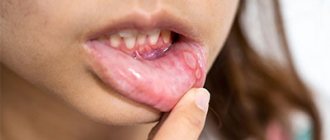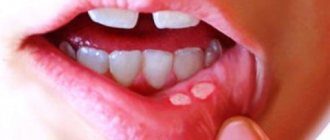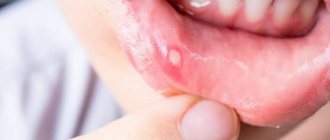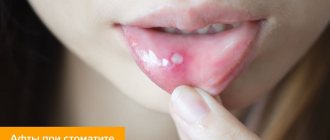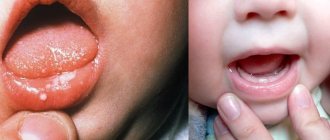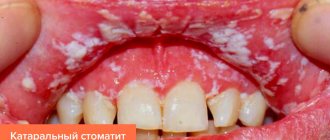Stomatitis is an inflammation of the mouth (but can also develop on the tongue and lips) that is most often diagnosed in children. Stomatitis in adults is usually a consequence of the introduction of viruses into the oral mucosa. In addition, this disease can occur in the presence of a number of other diseases, due to decreased immunity. For dentists, diagnosing and treating stomatitis in the mouth does not cause any difficulties, while attempts to get rid of the disease on their own can lead to unpleasant consequences
Causes of stomatitis
Stomatitis is both an independent disease and a manifestation of other diseases. The causes of stomatitis can be:
| CAUSES | A COMMENT | ||
| causes: | Viruses: | a comment: | herpes simplex virus, varicella-zoster virus |
| causes: | Mushrooms: | a comment: | yeast-like fungi of the genus Candida. |
| causes: | Bacteria: | a comment: | fusobacteria, streptococci, gonococci, mycobacterium tuberculosis, mycobacterium leprosy. |
| causes: | Allergy: | a comment: | stomatitis can be a consequence of food, household and drug allergies. |
| causes: | Injuries | ||
| causes: | Hygiene: | a comment: | Poor oral hygiene, this includes both the presence of dental deposits (tartar and plaque), and the presence of many foci of infection (caries and its complications), old fillings and crowns. |
| causes: | A number of diseases: | a comment: | — diseases of the digestive system (Crohn’s disease2, gastroesophageal reflux disease3, gastritis4) — chronic heart failure5 — diabetes mellitus6 — vitamin C hypovitaminosis — chronic tonsillitis — insufficient pancreatic function |
Classification of stomatitis by the World Health Organization7
| CLASSIFICATION | A COMMENT | ||
| classification: | According to the degree of damage to the mucous membrane | a comment: | 1) Superficial (catarrhal, fibrinous) 2) Deep (ulcerative, necrotic) |
| classification: | Due to the occurrence: | a comment: | 1) infectious (viral, bacterial, fungal) 2) traumatic (mechanical, chemical or physical injury) 3) allergic 4) arising from systemic diseases |
| classification: | According to the clinical course: | a comment: | 1) acute 2) chronic |
Catarrhal stomatitis
Characterized by redness, slight swelling, burning of the mucous membrane. It is observed with influenza, acute respiratory viral infections, and drug-induced damage.
Fibrinous stomatitis
It manifests itself as single painful aphthae, which are covered with a white coating. Afta is a superficial defect of the oral mucosa of a round shape. It appears in mild forms of aphthous stomatitis.
Ulcerative stomatitis
manifests itself in the form of deep defects in the oral mucosa - ulcers. Observed in traumatic stomatitis.
Necrotizing stomatitis
Characterized by ulcers that are covered with necrotic plaque. It is observed in ulcerative-necrotizing gingivitis, a complication of measles.
Acute stomatitis
It has pronounced symptoms, as a rule, it appears for the first time or recurs extremely rarely, once every few years. Also occurs due to acute trauma. Patients complain of severe pain, difficulty eating and sometimes even talking, general weakness, fever, and bad breath. Acute stomatitis with incomplete or improper treatment can become chronic.
Chronic stomatitis
Characterized by constant relapses, as a rule, this occurs when the immune system is weakened. May occur as a result of regular, moderate trauma. Clinical manifestations are less pronounced; this type of stomatitis always requires first of all eliminating the cause of the disease.
Types and forms of stomatitis
What types of stomatitis are there? Depending on what is taken as the basis for the classification, various forms and varieties of this disease can be distinguished. For example, according to the degree of damage to the mucous membrane, a distinction is made between catarrhal (superficial) stomatitis and ulcerative stomatitis.
According to the causes of occurrence, traumatic stomatitis, bacterial, candida, viral, prosthetic, drug, allergic and radiation are distinguished. The nature of the course of the disease and the presence of relapses make it possible to determine such forms of stomatitis as acute and chronic stomatitis.
To accurately determine the type of stomatitis in a particular case, it is necessary not only to carefully examine the oral cavity, but also to conduct tests for the presence of certain pathogens, and also take into account the presence of allergic reactions in the patient, chronic diseases (such as diabetes or gastritis) , pathologies of the immune system.
Chronic
Chronic stomatitis usually occurs as a continuation of advanced acute stomatitis and is characterized by a long course with periodic remissions and exacerbations. By origin, this is most often viral (herpetic) stomatitis. After treatment, the virus remains in the body and when the immune system is weakened again (due to stress, illness or other reason), it is activated and leads to relapse of stomatitis.
Chronic recurrent stomatitis can be not only viral in nature, but also bacterial, allergic, and candidiasis. The causative agents of many diseases are constantly present in the body, or easily enter it from the external environment. And if stomatitis was caused by an allergy to some substance or exposure, then it is very likely that with each contact with this allergen the stomatitis will return again.
Treatment of chronic stomatitis always includes the use of specific therapy aimed at suppressing the pathogen: antibacterial, antiviral, antifungal. It is also necessary to eliminate foci of infection (for example, carious cavities) and complete sanitation of the oral cavity with professional hygiene.
Bacterial
Bacterial stomatitis is caused by pathogenic microorganisms (for example, streptococci or staphylococci) that enter the oral cavity or are already in it (for example, in carious cavities, in the thickness of tartar) and infect the mucous membrane. This is facilitated by injury to the mucous membrane with sharp edges of teeth, rubbing dentures, or other objects.
Treatment of bacterial stomatitis involves the use of antiseptic and antibacterial agents. If the cause of stomatitis is a denture, then it should be cleaned with special means (for example, in an ultrasonic bath), or replaced with a more comfortable one.
Angular
Angular stomatitis is associated with the appearance of cracks in the corners of the mouth (“jams”). The main causes of this disease are lack of vitamins and bacterial (or fungal) infection. This type of stomatitis is characterized by damage to the outer surface of the lips.
Treatment for angular stomatitis depends on the type of infection. For fungal infections, fungicidal ointments and preparations are used. The streptococcal variety requires the use of antibacterial agents. Treatment is complemented by taking vitamins, eliminating their deficiency and raising the level of immune defense.
Viral
Viral stomatitis is caused by infection of the body with a virus. Most often (in about 80% of cases) this is the herpes virus. But besides it, stomatitis can be caused by almost any virus - chickenpox, measles, influenza, adenoviruses or rotaviruses. Typically, the onset of the disease is typical for a viral infection of this type - it may be fever, chills, runny nose, cough, or swollen lymph nodes. But after 1-3 days, characteristic symptoms of viral stomatitis appear: blisters form in the mouth, which later turn into ulcers, swelling of the gums, bleeding, and putrid breath may occur.
Viral stomatitis can be considered a complication of the underlying viral infection. Its causes (in addition to the virus itself) are reduced immunity and poor oral hygiene - the presence of untreated caries, periodontal disease, gingivitis.
Treatment of viral stomatitis involves first of all treating the underlying disease. In addition, the affected areas of the mucosa can be treated with local antiseptic drugs, anti-inflammatory and wound healing agents. Often in such cases, antiviral ointments or gels are prescribed, and vitamins, immunomodulators, and adaptogens are prescribed to maintain and strengthen the immune system.
Allergic
Allergic stomatitis is caused by exposure to allergens. In addition to the typical allergens that are well known to us, such as animal fur, pollen, foods such as honey, citrus fruits, etc., allergies can be caused by some medications, dental products and orthodontic structures (for example, acrylic dentures).
It often happens that an incorrectly manufactured prosthesis (for example, with a violation of the proportions of the material components) causes an allergic reaction and, as a result, stomatitis. When replacing the prosthesis with a correctly made one (without excess monomer in the composition), the allergy disappears. Symptoms of allergic stomatitis are redness of the mucous membrane (and with prosthetic stomatitis, this can be not only the areas under the prosthesis, but all parts of the tongue, cheeks, etc., in contact with the prosthesis), swelling, itching, and subsequently small blisters appear, often turning into sores.
When treating allergic stomatitis, it is important first of all to determine the cause of the allergy and remove contact with the allergen (eliminate foods that cause allergies, or replace the denture if this is the cause), and take antihistamines. The rest of the treatment involves the use of local antiseptic, anti-inflammatory and analgesic agents.
Herpetic
Herpetic stomatitis is one of the contagious forms of stomatitis. Moreover, contagiousness persists even for 2 weeks after recovery. In most cases, the herpes virus never completely leaves the infected body. It is in a dormant, inactive form, but can be activated when immunity decreases - due to stress, lack of vitamins, due to a severe respiratory disease. Therefore, herpetic (cold sore) stomatitis is often chronic.
An adult very often does not have a strong reaction to the effects of herpes and damage to the mucous membrane. In children, acute herpetic stomatitis can be accompanied by an increase in temperature, general intoxication; when the bubbles merge, burst and form erosion, the child may feel severe pain, which interferes with eating, drinking, and talking. Most often, rashes appear on the palate, tongue, and inner surface of the cheeks. But often they also affect the lips and gums. The danger of this type of stomatitis is that it can turn into gingivitis, so it must be treated.
Treatment of herpetic stomatitis always involves suppressing the herpes virus. Antiseptics (chlorhexidine) and even many antiviral drugs do not affect the herpes virus. Moreover, antibiotics have no effect on him. Special medications have been developed against herpes - acyclovir, valacyclovir, famciclovir. They should be taken only as prescribed by a doctor, in case of severe herpetic stomatitis.
Among the local antiseptics, you can use Miramistin (effective against both types of herpes viruses) and Hexoral (active only against HSV-1). Anti-inflammatory drugs (cholisal) and wound-healing agents (solcoseryl, actovegin, sea buckthorn and rosehip oil, vitamins A and E) perform well.
Candida
Candidal stomatitis often occurs in children under 3 years of age and is therefore often called childhood thrush. This disease is caused by the fungus Candida. It is distinguished by a characteristic white cheesy coating, which is practically impossible to remove mechanically. When trying to remove it, the patient experiences pain, and under the plaque a bleeding, swollen surface of the mucous membrane is found. At the onset of the disease, a person may feel dry mouth, a burning sensation, and white dots appear that merge to form a continuous plaque.
The decision on how to treat candidal stomatitis should be made by a doctor, especially when it comes to a child. For adults, antifungals and topical medications (such as candida) are almost always prescribed. Treatment of candidal stomatitis in children is often limited to the use of vitamins and immune-strengthening agents. To eliminate symptoms, use alkaline rinses and lubricate the mouth with iodine. Antifungal drugs are used only in cases of severe candidomycosis stomatitis.
Ulcerative
Ulcerative stomatitis is a more severe form of the disease than catarrhal stomatitis. Its peculiarity is that the lesion covers the entire thickness of the mucosa, in contrast to the catarrhal form, where it affects only the superficial layers. Deep damage to the oral mucosa causes great suffering to the patient, and after the ulcers heal, scars often remain. Treatment for ulcerative stomatitis depends on the cause of the disease. If an infection is present, antibacterial, antiviral or antifungal therapy is carried out, as well as a course of restoratives and vitamins. Treatment is carried out with means for topical use - antiseptic drugs (furacilin, chlorhexidine, miramistin), herbal decoctions, healing agents. If the cause is traumatic damage to the mucosa, dental procedures are indicated: removal of decayed teeth, treatment of caries, professional oral hygiene.
Vesicular
Vesicular stomatitis is most often enteroviral. It is usually transmitted from animals (or from people who are carriers of the virus) - by airborne droplets, contact and fecal-oral routes. Children most often suffer from it. One of the characteristic symptoms of this disease is a rash on the palms and soles (sometimes also on the face around the mouth, on the buttocks and genitals) - this is vesicular stomatitis with exanthema.
Watery rashes are quite painful and cause itching, which causes severe discomfort to the child, often leads to refusal to eat, and disrupts sleep. With proper timely treatment, the disease goes away without a trace, leaving lasting lifelong immunity. Unfortunately, there are several types of Coxsackie virus, so a person who has had vesicular stomatitis can become infected again with a different type of virus.
Treatment is mainly symptomatic and includes isolating the patient (to avoid infecting other people), taking painkillers, treating rashes with local antiseptics, using applications and rinses, taking vitamin complexes, and in some cases, antiviral and antihistamine drugs.
Aphthous
Aphthous stomatitis is characterized by the formation of aphthous stomatitis on the oral mucosa - one (less often two or three) round ulcers up to 1 cm in size, surrounded by a bright red border and covered with a gray-yellow coating. Touching them is very painful. Itching or burning is often felt before ulcerations appear. Other symptoms rarely appear - slight fever, weakness.
The cause of aphthous stomatitis is reduced immunity, the presence of foci of infection (chronic tonsillitis, pharyngitis, etc.), gastrointestinal diseases, allergic reactions (including to sodium lauryl sulfate contained in some toothpastes), trauma to the mucous membrane (biting), increased concentration of nitrates in food or drink.
If the situation of decreased immunity, exposure to infections or allergens is repeated, the disease may recur, taking on the character of recurrent aphthous stomatitis. With a mild course of the disease, there are no more than 2-3 relapses per year. More frequent attacks indicate a severe form of the disease.
Treatment of aphthous stomatitis involves eliminating contact with allergens, incl. Avoid toothpaste with sodium lauryl sulfate and avoid allergenic and acidic foods. Antihistamines are also often prescribed.
When deciding how to treat aphthous stomatitis, the doctor must conduct a thorough diagnosis and establish the cause of the disease. In accordance with this, a selection of antiseptic drugs (for example, miramistin or chlorhexidine), anti-inflammatory gels (for example, cholisal) and wound healing agents (solcoseryl) is made.
The severe course of chronic aphthous stomatitis often involves the use of more serious medications and methods: laser treatment, immunomodulators, glucocorticoids, but such drugs should be prescribed exclusively by the attending physician.
Viral stomatitis
Herpetic stomatitis
Caused by the herpes virus of the first, less often the second type.
It accounts for 80% of all stomatitis and occurs mainly in children, less often in adults. The prevalence of herpes simplex virus ranges from 65% to 90%8. Infection occurs through airborne droplets and household contact. More common is recurrent herpetic stomatitis, which is manifested by itching, burning, slight soreness in the oral cavity, then vesicles (bubbles) appear, which burst and heal after 7-10 days.
During primary infection, acute herpetic stomatitis occurs; it is characterized by general symptoms such as fever, weakness, aches in the muscles and joints, the degree of these manifestations depends on the severity of the disease. As a rule, the acute form occurs in children.
Varicella zoster virus infection
The mildest form, in which the mucous membrane of the tonsils is affected. The palatine tonsils are not very enlarged, the mucous membrane of the throat is red, there is no plaque or pus.
Stomatitis with measles
Measles is an acute viral, highly contagious disease that is caused by the Polinisa virus and is transmitted by airborne droplets. The disease is extremely contagious. It is characterized by a rise in temperature, symptoms of ARVI, a rash on the face, neck, and then the whole body. In the oral cavity, Filatov-Koplik spots and stomatitis occur, which is characterized by hyperemia, swelling of the mucous membrane and white plaque. Nowadays, thanks to vaccination, this disease practically does not occur.
3.Herpes
Herpes on the lips
appears due to a virus called herpes simplex virus type 1. Unlike ulcers, herpes is contagious from the moment the herpes blisters rupture until complete recovery. Primary infection often occurs during childhood and can be confused with cold or flu symptoms. Once a person becomes infected with the herpes virus, the virus remains in the body and lies dormant most of the time. But during stress, colds, injuries, hormonal changes, under the influence of sunlight, the virus is activated and herpes appears on the lips.
Herpes tends to appear in the same place. And in addition to infecting other people, the herpes virus can spread to other parts of the infected person's body - the eyes and genitals.
About our clinic Chistye Prudy metro station Medintercom page!
Stomatitis caused by fungi
Candidal stomatitis is a fungal disease caused by fungi of the genus Candida.10 Young children and the elderly are more often affected; people with diabetes and xerostomia (dry mouth), pregnant women and people with weakened immune systems are also at risk. Elderly people wearing removable dentures often get sick.
The main symptom of fungal stomatitis is a burning sensation and the presence of a white, cheesy coating, when removed, a swollen, red mucous membrane appears. The general condition of adults with candidal stomatitis is practically not affected.
Bacterial stomatitis
Vincent's ulcerative necrotizing stomatitis
It manifests itself as ulcerations of the mucous membrane, strong odor from the mouth, fever, weakness, pain when eating. In severe forms, ulcerations can occupy almost the entire oral cavity, and the temperature rises above 38°C.
Gonorrheal stomatitis
Caused by Neisser's gonococcus. The mucous membranes of the lips, gums, lateral and lower surfaces of the tongue are mainly affected. The mucous membrane has a brightly hyperemic color and a large amount of gray purulent plaque with an unpleasant odor. But, as a rule, there are no complaints.
Acute streptococcal gingivostomatitis
It is characterized by general damage to the gums, severe pain, fever, enlargement and tenderness of the lymph nodes. The mucous membrane of the mouth and tonsils is hyperemic, abscesses may form.
Signs and symptoms of stomatitis
The symptoms of acute stomatitis are very similar for different types of this disease, although there are differences that make it possible to more accurately diagnose the disease. The location of the rash does not always indicate the form or causes of the pathology. The symptoms of stomatitis on the tongue or in the throat are generally the same; much more important is the nature of the manifestations, the presence of rashes - small blisters or one large ulcer. The severity of the inflammatory process allows us to judge whether the disease is milder, catarrhal, or more severe. For example, the symptoms of catarrhal stomatitis include only:
- redness and swelling of the mucous membrane,
- soreness, sometimes bleeding gums,
- bad breath,
- increased (or, on the contrary, decreased salivation),
- Sometimes a white sticky coating appears.
But at the same time, there are no rashes or ulcers, the temperature rises very rarely and slightly, the lymph nodes are not enlarged. It would seem that this indicates the stability of the immune defense and an easy and quick cure, however, even this form of stomatitis needs treatment, otherwise, once neglected, it can become more severe, ulcers will appear, a bacterial infection will join, which will spread to neighboring organs, causing serious complications.
So, let us highlight the symptoms of the disease characteristic of stomatitis:
- redness and swelling of certain areas of the mucous membrane,
- blisters, blisters or sores (not always),
- pain, burning, itching in the affected areas, which intensifies when touched, eating, talking,
- bad breath,
- plaque (white or grayish-yellow) on the affected areas,
- fever, chills (not always, more often in children than in adults),
- signs of intoxication - weakness, headache, nausea (not always).
Symptoms of stomatitis in newborns are slightly different. Most often this is:
- temperature increase,
- baby's refusal to breastfeed,
- restlessness and moodiness of the baby,
- small blisters or sores on the oral mucosa.
The most common causes of stomatitis in newborns are the herpes simplex virus (65%) or the Candida fungus (30%). In the case of herpes, blisters with transparent contents appear on the mucous membrane, which soon burst, forming ulcers. With candidal stomatitis, white dots appear that merge to form a solid white coating. Since damage to the mucous membrane causes pain and burning, the baby refuses to eat, which is very dangerous, as it leads to weight loss and dehydration.
Temperature with stomatitis
The question of whether there can be a fever with stomatitis usually worries the parents of a sick child, who are trying to understand whether it is worth seeing a doctor. Yes, with stomatitis in children, the temperature very often rises. In general, the signs of stomatitis in children are usually more pronounced than in adults, due to the fact that the child’s immune system still reacts to infections and inflammation quite violently.
But even in adults with stomatitis, the temperature may rise, especially with a more severe course of the disease.
You need to know how long the temperature lasts for stomatitis. Usually this is several days, but depending on the cause of the disease and the severity of its course, this time may be shorter or longer. In any case, you should definitely consult a doctor - correct diagnosis and proper treatment can shorten this period and prevent the disease from developing into a complicated form.
Which doctor should I contact if I have signs of stomatitis?
Which doctor treats stomatitis? At the first signs of stomatitis, you should go to a doctor who treats diseases of the oral cavity - a dentist. He will determine the type of disease and its causes, prescribe treatment, and, if necessary, refer you for tests or to a specialized doctor to clarify the diagnosis.
If manifestations of stomatitis are noticeable in a child, then you should contact your local pediatrician.
Diagnosis of stomatitis
Successful healing requires correct diagnosis of stomatitis. Only a doctor with the necessary knowledge and professional experience can accurately determine the type of disease, establish the causes and propose treatment tactics taking into account the individual characteristics of a particular patient.
On the one hand, this disease has very characteristic symptoms and stomatitis is relatively easy to diagnose. On the other hand, stomatitis may be concomitant with another, more serious disease. The effectiveness of the medications and treatment methods used directly depends on the correct identification of the causes that caused stomatitis.
Treatment of stomatitis in adults
Adults usually tolerate stomatitis more easily than children, however, stomatitis in adults also requires treatment, since if it is neglected, it can become more severe, cause serious complications, and become chronic.
Treatment of stomatitis in adults should always be based on identifying the causes of the disease. If the cause is an allergy, then it is necessary to identify the allergen and eliminate contact with it. If the cause is a bacterial or viral infection, then a course of antibacterial or antiviral therapy should be administered. Depending on the specific diagnosis, the most effective painkillers, antiseptic, anti-inflammatory and healing agents in a particular case are selected. To the question - how to treat stomatitis in adults? — the dentist must answer. In no case should you self-medicate, as this can have the opposite effect and lead to a worsening of the situation.
Treatment of stomatitis includes:
- Elimination of the cause of the disease (allergy or viral infection, bacterial contamination).
- Local treatment - rinsing with antiseptics and herbal decoctions, using anti-inflammatory and healing gels.
- Suppression of acute conditions - reduction of high temperature, pain relief.
In addition to systemic treatment aimed at suppressing infection, antihistamines are often used, and local treatment - rinses, applications, ointments and gels, the purpose of which is to clean the surface of the mucous membrane from plaque with microorganisms, prevent the proliferation of pathogenic microflora, reduce inflammation, eliminate pain, and stimulate regeneration of damaged tissue.
How to rinse
Mouth rinsing for stomatitis is aimed at mechanical removal of dead epithelial cells, mucus containing pathogenic microflora, as well as the death of harmful microorganisms and suppression of their reproduction.
One of the best antiseptics is Miramistin - it has not only antimicrobial activity, but also antiviral activity (including against both herpes simplex viruses). It also restores local immunity of the mucous membrane.
The second rinse option is chlorhexidine. It has less antiviral protection, but more actively suppresses bacteria, and most importantly, it leaves an indelible layer of the drug on the mucous membrane, which prolongs the rinsing effect.
Furacilin and other antiseptics give good results. Hexoral contains not only an antiseptic, but also anti-inflammatory and analgesic components.
Rinsing with herbal decoctions helps with stomatitis: chamomile, sage, calendula, eucalyptus, etc. But you need to understand that these remedies are auxiliary, not primary - you should not rely on them alone in the treatment of such a serious disease as stomatitis.
Soda for stomatitis
Rinsing with soda for stomatitis has two advantages: first of all, soda softens and helps remove mucus and bacterial plaque. In addition, it creates an alkaline environment, which is destructive for many harmful bacteria, fungi and viruses.
Soda solution for stomatitis does not cause burning or pain, has no contraindications, and is suitable even for children. To prepare it, you need to dissolve 1 teaspoon in 200 ml of warm water. The solution will help reduce swelling and pain, soothe the mucous membranes, and slow down the development of harmful microorganisms.
Stomatitis during pregnancy
Stomatitis occurs very often in pregnant women. The reason for this is weakened immunity, lack of vitamins, and hormonal changes in the body. It is necessary to treat this disease only under the supervision of a doctor, since only a doctor can prescribe medications that will not harm the health of the mother and her unborn baby.
To avoid stomatitis during pregnancy, it is necessary to visit the dentist in advance and perform a complete sanitation of the oral cavity - cure caries, remove tartar, and solve all other problems. And also regularly and carefully care for your oral cavity throughout the entire period of pregnancy, take care of your health and follow all doctor’s recommendations.
Antibiotics for stomatitis
In all cases, antibiotics are prescribed only by a doctor. They are effective only against bacterial infections and the forms of stomatitis caused by them (for example, with Vincent's ulcerative necrotizing stomatitis). Viral types of stomatitis cannot be cured with antibiotics. The success of treating stomatitis with antibiotics directly depends on correct diagnosis and accurate selection of the most effective drugs and dosages in a particular case.
Traumatic stomatitis
Traumatic stomatitis develops as a result of mechanical, thermal or physical trauma. This type of stomatitis occurs:
- superficial (burn of the mucous membrane by hot tea)
- deep (burn with a strong alkali or acid, strong biting of the mucous membrane)
Acute mechanical stomatitis: rare, it can be caused by trauma to the mucous membrane when biting the cheek, tongue, lip while eating, an attack of epilepsy, a blow, trauma during dental treatment and other traumatic factors.
It is manifested by pain, hyperemia, swelling at the site of injury, erosion. With secondary infection, the wound can develop into long-term non-healing ulcers. Most often, traumatic stomatitis is acute, but can also be chronic, for example, constant biting of the cheeks under stress, chronic injury from braces, a sharp tooth edge, or a bad crown. As a result of trauma, painful erosions or ulcers with jagged edges form on the mucous membrane, which can become infected.
The cause of physical injury is most often a thermal burn due to contact with hot liquid, inhalation of steam, or exposure to fire, the latter, as a rule, accompanied by damage to the respiratory tract. The lesion is most often located on the tip of the tongue, lips, and the front of the palate. The mucous membrane becomes swollen, red, painful, and blisters may form, which then burst. With deep damage, the mucous membrane dies, and the damage involves muscles and even bone.
Chemical stomatitis occurs when burned with acid or alkali. In everyday life, this is most often acetic acid; also at a dental appointment, burns can occur with various drugs (phenol, formaldehyde, alcohol, hydrofluoric acid, etc.). The depth of damage depends on the damaging substance and its concentration, and the duration of exposure. First, the mucous membrane becomes bright red and painful, and with severe lesions, foci of necrosis then appear within a few hours.
In case of burns with acids, alkalis, or thermal burns, it is recommended to call an ambulance!
How does stomatitis manifest in adults?
Local symptoms include redness, swelling of the mucous membrane, spots, ulcers or wounds in case of mechanical damage1,3. They cause pain or burning5. Plaque may form in the area of inflammation. Sometimes a person complains of bad breath3. The listed symptoms can be severe or minor - it all depends on the depth of the lesion and the duration of the disease3.
In addition to local symptoms, in severe cases there are general ones, similar to those that appear with a cold - increased body temperature, general weakness and lack of appetite2.
to come back to the beginning
Allergic stomatitis
They arise as a reaction of the mucous membrane to an allergen. An allergic agent can be toothpastes, mouthwashes, food, medicines, materials for crowns, fillings, etc. Allergies often occur to removable dentures. The mucous membrane is affected precisely at the point of contact with the damaging agent, for example, the hard palate under a removable denture. With allergic stomatitis, the mucous membrane is swollen, red, bubbles appear, which burst with the appearance of painful erosions.
Allergic stomatitis also includes chronic recurrent aphthous stomatitis , it begins with swelling and burning, then a painful aphtha appears, and then a healing period begins. This disease is characterized by constant relapses with a certain frequency.
Possible complications
If stomatitis in the mouth is left untreated, it will certainly lead to negative consequences, from gum inflammation to tooth loss. That is why it is extremely important when treating stomatitis to strictly adhere to the recommendations given by your dentist. The list of major potential complications includes the following diseases.
- Chronic stomatitis.
Statistically, this is the most common complication. An untreated inflammatory process becomes chronic and recurrent, which means that an infectious focus will always be present in the body. - Appearance of scars.
A symptom such as bleeding gums can be a manifestation of many diseases, but with stomatitis, due to constant non-healing cracks in the oral cavity, scar tissue forms, which in the future may not allow the patient to open his mouth wide. - Laryngitis.
If the infection spreads up the respiratory tract, the patient's voice becomes hoarse and a cough appears. - Vision problems.
With advanced herpetic stomatitis, the target of damage becomes not only the gums, but also the mucous membranes of other organs. Most often, these are the eyes and genitals. - Loss of teeth.
The most dangerous complication of stomatitis. The main threat is the fact that the destructive process can last for many years and may not be noticeable to the patient at first. First, periodontal disease will develop - serious damage to periodontal tissue. And only then, as a consequence, the teeth will gradually become looser until they fall out.
Prevention of stomatitis
Consists of the following items:
- strengthening the immune system, giving up bad habits, hardening, playing sports, eating with a sufficient amount of macros and vitamins (especially vitamin C)
- regular visits to the dentist
- adequate brushing of teeth at home, as well as removal of dental plaque in the dentist’s office once every 6 months
- identifying the allergen and avoiding contact with it
- undergoing medical examination for timely detection of diseases
- treatment of systemic diseases
- taking antibiotics only as prescribed by a doctor, together with a course of probiotics, to avoid dysbiosis
- vaccination (against measles, chickenpox)
Tantum® Propolis
It is worth paying attention to Tantum Propolis, since propolis has an immunostimulating effect, promotes healing, and vitamin C, which is part of it, is responsible for regeneration, participating in the synthesis of collagen.
Propolis also has antiviral and antifungal effects. Therefore, vitamin therapy Tantum Propolis is an effective means of preventing stomatitis.12 Find out more
How to treat the disease
Therapy involves the use of local and sometimes systemic drugs. The treatment regimen for the disease depends on what type of stomatitis is diagnosed. For this reason, you should not self-medicate, as it may turn out to be useless and the pathology will continue to develop into dangerous conditions.
The exception is mild catarrhal inflammation associated with poor hygiene. It is enough to exclude the cause and rinse your mouth with antiseptics for several days.
Treatment at home for other types should be discussed with your doctor. The use of folk remedies is not contraindicated, but they can only be used as a supplement to the main therapy. Only a dentist can evaluate the appropriateness and harmlessness of a particular prescription.
Effective drugs for adults
To relieve inflammatory processes, combat pathogenic microflora, and relieve pain, rinses, gels, sprays, lozenges, and ointments are prescribed. For severe pain, pain medications can be taken orally. Since treatment must be carried out regularly, it is important to choose a medicine for stomatitis that will be convenient to carry in your purse and use at work.
Popular medicines:
- Chlorophyllipt, Inhalipt, which have an antiseptic effect. Available in the form of sprays. Apply up to 5 times a day for one week. Sprays are convenient to use if there is stomatitis in the palate or throat.
- Solcoseryl accelerates tissue regeneration, restores mucous membranes, and protects against the development of ulcers. The gel is applied several times a day. The course is from 7 to 14 days.
- Cholisal has a detrimental effect on bacteria, relieves inflammation, and improves tissue healing. The gel is used three times a day for at least a week. An analogue of the drug is Kamistad. Excellent help with aphthous, bacterial form of the disease.
- Viferon, Acyclovir are prescribed to patients with a viral infection. Ointment for stomatitis in the mouth is applied to areas of inflammation several times a day. The course of therapy is up to 2 weeks.
- Lidocaine Asept, Lidochlor are used for any form of pathology, since the main purpose is to relieve acute pain. Available in spray form. Can be used up to four times a day, no more than 1 week.
- Lugol kills bacteria, treats ulcers, and relieves inflammatory processes. The oral cavity is treated with a spray 2 - 3 times a day.
- Miconazole and Nystatin are prescribed for fungal infections. In severe cases of the disease, the ointment is used in combination with systemic medications. Apply to affected areas 2 to 4 times a day.
Any medication for stomatitis must be prescribed by a doctor. The symptoms of the varieties of the disease are similar and it is impossible to independently understand the cause of the inflammatory reactions.
What can you rinse your mouth with?
To treat pathology, you can use pharmaceutical drugs aimed at destroying bacteria, reducing inflammation and healing tissue.
Medicinal solutions that can be bought at the pharmacy:
- Aqualor with sea salt;
- Stomatofit, Dr. Theiss Sage based on sage;
- Romazulan with chamomile extract;
- Chlorhexidine (pre-diluted with water).
Decoctions and infusions for rinsing are easy to prepare at home from chamomile, calendula, aloe juice, sea buckthorn, linden flowers and other medicinal plants. A solution of salt and soda helps a lot.
Treatment of stomatitis
Treatment of stomatitis depends on the severity and cause of the disease and includes the following measures:
1. For bacterial stomatitis, antibacterial drugs are prescribed. For fungal stomatitis - antifungal drugs, for viral ones - antiviral drugs
Important! Antibiotics, antiviral and antifungal drugs are prescribed only by the attending physician!
2. For high fever and pain, antipyretic and painkillers are prescribed
3. Vitamin therapy. It is especially important to take vitamins A, C, E
4. Immunomodulatory drugs
5. Antiseptic treatment of the oral cavity. Antiseptics are used in the form of solutions, sprays, tablets, ointments
6. Epithelializing agents are used after acute phenomena have subsided
7. Sanitation of the oral cavity, removal of dental plaque
8. A gentle diet
9. Eliminating allergens and taking antihistamines
Important! Stomatitis is treated by a dentist, in some cases together with a therapist, infectious disease specialist, allergist and dermatologist. If you have symptoms, consult a specialist.
Features of treatment in children
The dentist will tell you how to treat aphthous stomatitis in a child. You can contact him at the direction of your pediatrician or on your own if you find characteristic ulcers in the oral cavity. The treatment regimen is the same as that used in the treatment of adult patients, but there are some differences: children under a certain age cannot rinse the mouth, so preference is given to drugs for application to mucosal ulcers. Otherwise, the treatment regimen is developed individually, taking into account the severity, symptoms of the disease, frequency of relapses, and the presence or absence of concomitant ailments in the child. Symptomatic therapy can be used to quickly alleviate the baby’s condition.
Specialists at STOMA clinics successfully treat aphthous stomatitis. By contacting us, you will receive qualified assistance, detailed recommendations on the treatment and prevention of relapse of the disease, and comprehensive assistance from dentists of all specializations, if necessary.
Answers to popular questions
Which doctor treats stomatitis?
The dentist, if necessary, can refer the patient to other doctors.
Do I need to take antibiotics for stomatitis?
Some forms of stomatitis require the use of antibacterial agents, but in most cases this is not only useless, but even dangerous, since it can lead to dysbacteriosis. Antibiotics should be taken only as prescribed by a doctor in the prescribed dosage.
How long does it take to treat stomatitis?
Depends on the severity and form of the disease. On average 7-10 days.
Is stomatitis contagious?
Not all forms of stomatitis are contagious. Traumatic stomatitis is absolutely not contagious. If stomatitis is caused by viruses, such as herpes or measles, the risk of infection is very high.
Diagnostic features
At the initial appointment, the dentist examines the oral cavity and analyzes complaints. To make an accurate diagnosis, you need to distinguish this form of the disease from others, as well as differentiate it from other pathologies that have similar symptoms. For extensive lesions, different diagnostic methods may be used:
- clinical blood tests;
- microflora smear;
- blood for PCR to determine the causative agent of the disease;
- biopsy (if indicated).
They are also necessary for recurrent forms of the disease. In simple cases, laboratory diagnostics are not required; aphthae are determined visually by an experienced specialist.
With the help of a comprehensive examination, the doctor will determine which microorganism caused inflammation with subsequent ulceration of the mucous membrane. He also differentiates the disease from herpetic stomatitis and oncological pathology.

